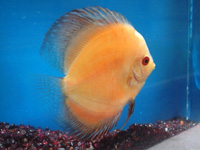Discus - Pineapple
Scientific Name: Symphysodon discus willischwartzi
Fri, 11th April, 2025 - 11:12 pm GMT
Sponsor Ads:

Alternative Name
Scientific Name: Symphysodon discus willischwartziBasic Info
The Pineapple Discus is an amazingly bright yellow, sometimes yellow-orange, color. It has vertical stripes over its body, in a lighter shade of creamy yellow or white. The Pineapple Discus is shaped, like all Discus, in a vertically flattened manner. It is, essentially, circular in shape, like a disc.
Health
An adult pair of Pineapple Discus should be offered plenty of space. Water temperatures should remain between 82 and 86 degrees Fahrenheit (28 to 30 degrees Celsius). The water should be soft and slightly acidic, with a pH level of about 6.6 and a water hardness between 10 and 15 dGH. Carbonate hardness, specifically, should remain between 6 and 8 dKH. Plenty of hiding places should be provided; often plants are preferred. The addition of peat moss to the tank as a substrate or in a filter is sometimes used to condition the water. Water changes should occur regularly; on a weekly basis, about 20 percent of the water should be replaced. This is because Pineapple Discus are intolerant of high nitrite or nitrate levels. Pineapple Discus should be kept in pairs or small groups, and may be kept with other small, non-aggressive fish. However, the addition of other species to a Discus enclosure may stress them. Omnivorous by nature, most Pineapple Discus can be fed on a variety of items. Often frozen brine shrimp, blood worms, or beef heart are offered. Pineapple Discus also tend to nibble on plants in their enclosures. Many are maintained nicely on flake or pellet foods. Pineapple Discus should be fed small amounts of food several times daily to avoid soiling the water. Because Pineapple Discus are usually sensitive to internal parasites, you should use caution when adding other fish to their enclosures. Breeding Often, groups of juvenile Pineapple Discus are combined in order to form bonded pairs, which will then be separated into separate breeding tanks. To breed Pineapple Discus, water temperatures should be raised to a level between 86 and 89 degrees Fahrenheit (30 and 32 degrees Celsius). The pH level should be adjusted to a level between 6.0 and 6.8, with a dGH between 3 and 10 and a dKH that is undetectable or as high as 3. Some hard surface, like a potted plant or slate slab, should be provided, so the Pineapple Discus pair is able to deposit its eggs somewhere.Habitat
Fresh water fish - They seem to prefer areas of slow moving black water, with plenty of covered hiding areas.Behavior
With its bright, tropically sunny coloration, the Pineapple Discus can add a splash of cheerful color to many aquariums. Although Discus have reputations for being rather difficult to maintain, many enthusiasts maintain that, so long as water conditions are correct, Discus are not as hard to keep as one might think! In captivity, Pineapple Discus should be allowed plenty of hiding places in order to prevent them from becoming stressed. It is usually recommended that Pineapple Discus be kept in groups of six to eight fish of the same species. In smaller tanks, it is advisable to keep a pair, as a single fish may become easily stressed. In the wild, Pineapple Discus occur in groups of related fish. They may be kept in captivity with small fish, like Dwarf Gouramis or Clown Loaches, though it is not recommended to combine them with large, aggressive, or overly active fish.Origin
AmazonHistory
Pineapple Discus are native to South America. They are found specifically in the Rio Abacaxis, located south of the Amazon River.Common Foods
N/ASponsor Ads:
"Thus one who is skillful at keeping the enemy on the move maintains deceitful appearances, according to which the enemy will act. He sacrifices something, that the enemy may snatch at it." -- Sun Tzu, The Art of War
Discus - Pineapple
Coded by: BGID® | ALL RIGHTS RESERVED Copyright © 2000-2025
Disclaimer | Privacy | Report Errors / Contact | Credits








 President of the United States of America - Real Estate mogul, Pageant owner and now one of the most controversial men in political history.
President of the United States of America - Real Estate mogul, Pageant owner and now one of the most controversial men in political history.  Politician, US Vice President and President of the USA - Joseph Robinette Biden Jr.
Politician, US Vice President and President of the USA - Joseph Robinette Biden Jr.  versus
versus  Russia: 'The Evil Empire'? Are they all that bad or is it just the USA trying to portray Russia as bad because they are a world power with land bigger and a society very different from the USA ideal?
Russia: 'The Evil Empire'? Are they all that bad or is it just the USA trying to portray Russia as bad because they are a world power with land bigger and a society very different from the USA ideal?  Global warming has been in and out as the "latest" hot topic for many years. It is, according to modern scientists, the result of man-made industrial pollutants, clearing forested areas, agriculture, etc. But now they are thinking it started way before the Industrial Revolution...
Global warming has been in and out as the "latest" hot topic for many years. It is, according to modern scientists, the result of man-made industrial pollutants, clearing forested areas, agriculture, etc. But now they are thinking it started way before the Industrial Revolution... 
 Corona virus
Corona virus 
 Users with wide screen monitors can benefit from more content on every page.
Users with wide screen monitors can benefit from more content on every page.